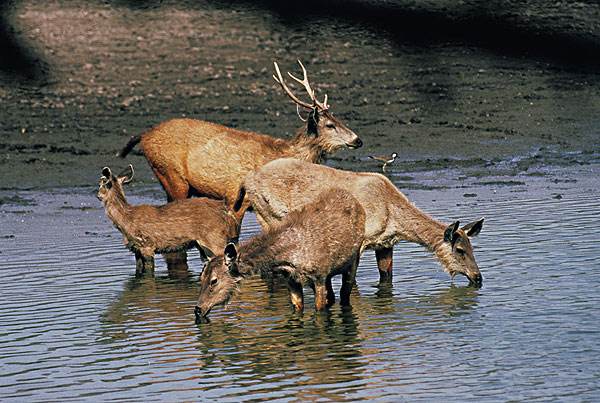Rusa unicolor
IUCN
LCBasic Information
Scientific classification
- name:Rusa unicolor
- Scientific Name:Rusa unicolor, Sambar, Indian Sambar, Sambar Deer,Indischer Sambarhirsch, Pferdehirsch, Sambar,Cervus unicolor Kerr,Black deer, spring deer
- Outline:Ungulata
- Family:Artiodactyla Ruminantia Cervidae ambar
Vital signs
- length:140-260cm
- Weight:100-200kg, the largest can reach more than 300kg
- lifetime:14-16years
Feature
It is the largest deer species in tropical and subtropical regions.
Distribution and Habitat
Distributed in Bangladesh, Bhutan, Brunei, Cambodia, China (Guangxi, Guizhou, Hainan, Hunan, Jiangxi, Sichuan, Yunnan, Taiwan), India (Sumatra), Laos, Malaysia, Myanmar, Nepal, Sri Lanka, Thailand and Vietnam.
Introduced: Australia, New Zealand, St. Vincent and the Grenadines, South Africa, United States (California, Florida, Texas).
Lives in tropical rainforests at medium and high altitudes. Likes to move after sunset, has no fixed nest, and has the habit of vertical migration along the hillside. Its range of activities is large, it has no fixed nest, and rarely goes to places far away from water.
Appearance
The body length is 140-260 cm, the tail length is 20-30 cm, the shoulder height is 120-140 cm, and the weight is 100-200 kg. The largest one can weigh more than 300 kg. The stag has thick and long three-pronged antlers, the longest of which can reach 1 meter. The coat color is light brown or dark brown, and the female deer is slightly reddish. There is dark brown mane on the neck. The body hair is generally dark chestnut brown, with no white spots on the arms, and yellowish white under the jaw, abdomen, inside of the limbs, and under the tail.
The body is tall and stout, with rough and sparse body hair. The back of the stag is generally dark brown or dark brown, and the belly is yellowish white. The body color of female deer is lighter and slightly reddish than that of male deer, and there are also tan and gray-brown individuals. The dark brown vertical stripes on the neck along the midline of the back to the tail are one of the distinctive features of the sambar deer. The face is s
Details
Sambar, also known as the water deer in English, has 8 subspecies and is the largest deer in tropical and subtropical regions.

The important features that distinguish the water deer from other deer species are: small horns and few forks; movable incisors; a palm-sized piece of inverted hair on the neck and abdomen; and the hair is rounded and wavy.
Sambar deer are sensitive, alert, good at running, and like to live in groups. Sambar deer are mostly active at night, usually foraging at dusk or at night, and resting in dense forest cover during the day. These deer are solitary, but may form groups during the mating season. In addition, up to 6 females and their cubs can be grouped together. Males are wandering and walk, mainly establishing territories during the breeding season. All sambar deer are good and skilled swimmers. They like to bathe in mountain streams in summer.
The breeding season of sambar deer is not very fixed, and they can mate every month, mostly in late summer and early autumn every year. The gestation period of female deer is about 6-8 months, and they give birth in the spring of the following year. The estrus cycle averages 20 days, the average gestation period is 8-9 months, and each litter has 1-2 calves. The lactation period is 12-24 months, and their fertility is relatively low. The cubs have white spots on their bodies. They are fully developed at 2-3 years old.
The severity of the danger to sambar deer varies in different regions. In mainland Southeast Asia (Vietnam, Laos, Thailand, Cambodia, Myanmar, Malaysia), Bangladesh, Borneo and Sumatra, the decline is more than 50%. The overall decline in India has been relatively small, but the decline in these areas outside India is large, with an average decline of 30% in China, Sri Lanka and Nepal. The slowing trend of population decline indicates that the marketing of wild meat and antlers in Southeast Asia and China has declined. In February 2022, staff at the Xingang Provincial Nature Reserve in Heyuan, Guangdong, discovered the largest national key protected wild animal in Guangdong Province - sambar deer while conducting biodiversity monitoring.
Listed in the IUCN Red List of Threatened Species in 2014 ver3.1 - Vulnerable (VU).
Listed in Appendix I, Appendix II and Appendix III of the Convention on International Trade in Endangered Species of Wild Fauna and Flora (CITES) 2019 edition.
Listed in China's National List of Key Protected Wildlife (February 5, 2021) at level II.
Protect wildlife and eliminate game.
Maintaining ecological balance is everyone's responsibility!








